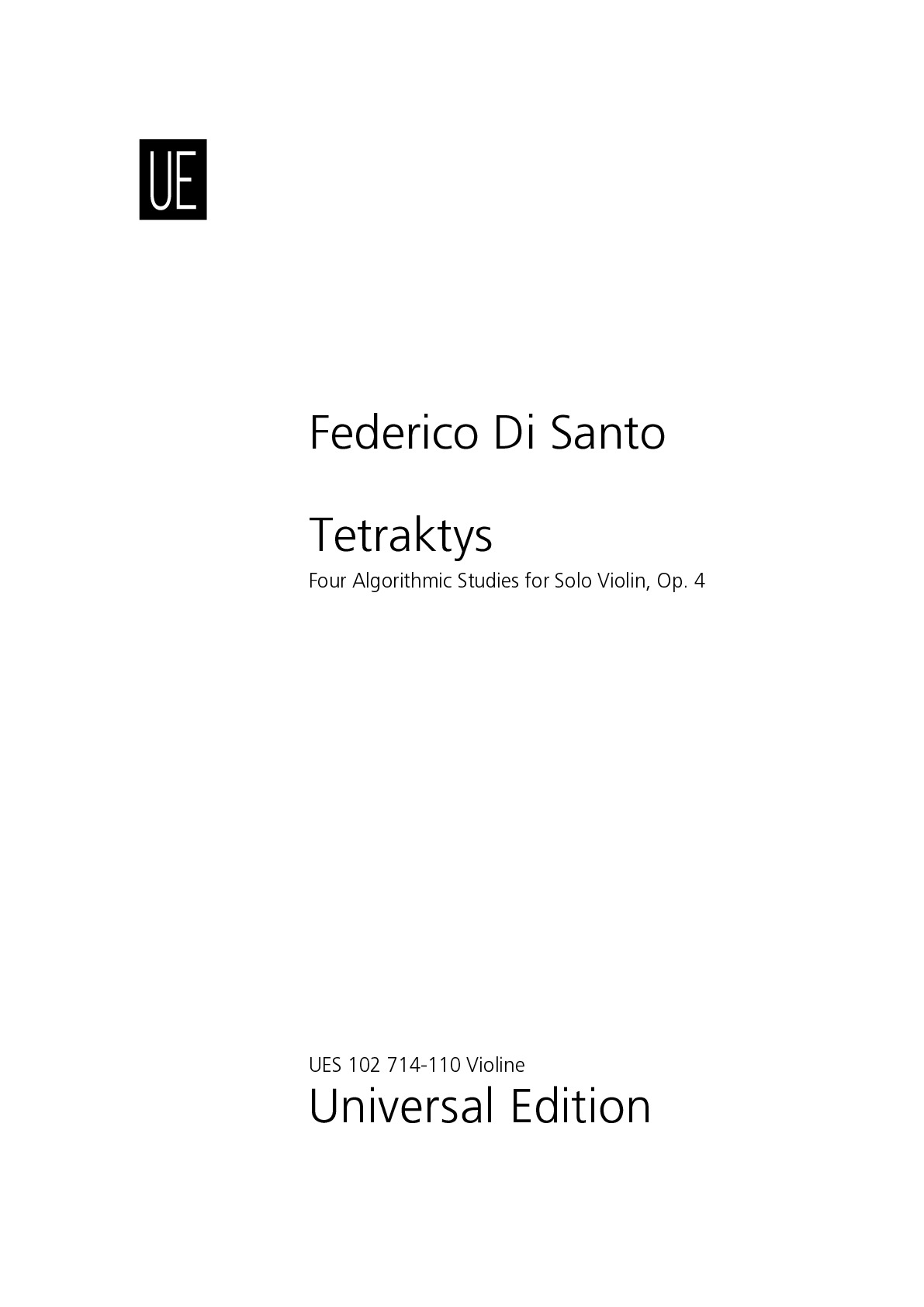

Federico Di Santo
Tetraktys
Duration: 7'
Solos:
violin
Tetraktys
Sample pages
Video
Work introduction
"Tetraktys" is a collection of four etudes for solo violin, all displaying a high level of technical difficulty. The title, of a Xenakisian flavour, refers to the sacred Pythagorean tetrad of the first four integer numbers represented in the form of an equilateral triangle: at a more superficial level this alludes to the number of pieces in the collection ("tetraktys" means "tetrad" in ancient Greek), but at the same time it also alludes more subtly to the mathematical and algorithmic nature of the compositional procedures underlying these pieces, as well as much music of the second half of the 20th Century. Although conceived as independent studies, they can also be performed in succession as movements of a single piece, a sort of contemporary sonata or suite for solo violin. Either the character or the title of the four studies allude to this unity of structure: for example, the first study ("Vexations rythmiques"), with its continuous repetition of very similar rhythmic figures, recalls a prelude, the second, as the title indicates, recalls some distinguishing features of the “courante” (especially Bach's), the third ("Pizzicato Counterpoint") shows a contrapuntal texture evoking the fugue present all three of Bach's solo violin sonatas, and the last ("Algorithmic Waves") has the character of a final presto. A similar overall structure, with marked Bachian allusions, can be found in György Ligeti’s sonata for solo viola.
In spite of the allusion to Xenakis in the title, the algorithmic procedures behind the four etudes look more towards some typical techniques of Franco Donatoni, even if they lead to results that sound mostly very different from his style (only the last study sounds closer to Donatoni's sonorities). By algorithmic procedures I do not refer here to processes entirely automated or implemented through computer processing: I refer, instead, to simple algorithms applied manually to a starting musical material, in the manner of Donatoni (e.g. “Argot” for solo violin or “Lame” for solo cello). These algorithms operate by producing a series of "re-readings" of those original materials, making them gradually change and develop it in a continuous metamorphosis. Other secondary algorithms can progressively be added to the main algorithm at each re-reading, thus making it possible to achieve an adequate degree of elaboration on the level of pitch, rhythm, performing techniques, ornamentation, etc. This also allows the composer to always maintain control over the texture and sound result, which are never automatically produced by predetermined and unchangeable rules. Through modifications which are sometimes almost imperceptible, sometimes more marked, the sonic material constantly evolves in a very gradual and almost unnoticed way, generating at the same time both variety and a strong coherence and unity in the character and sonority of each one of the four pieces. As studies for solo instrument, they also present two typical features of the musical genre of the "etude", namely the fact of being “designed primarily to exploit and perfect a chosen facet of performing technique” (Grove Music) and that of being structured on the repetition of very similar musical figures or patterns, which is particularly evident, to the point of excess and parody, in the first study.
Going into more detail, the first study ("Vexations Rythmiques") concentrates on the 1-string and then 4-string ricochet bowing, on very big skips and on left-hand pizzicato. The title, recalling Eric Satie’s "Vexations", alludes to the obsessive character of the rhythmic figure that pervades the entire study, a close reminiscence of a famous passage in Paganini’s Capriccio n. 9 (mm. 61-92). Its obsessive resurfacing makes the study almost a parody of that famous virtuoso passage and, more in general, of the repetitive nature of the technical etude. At the compositional level, the starting material consists of the first two measures: the subsequent "re-readings" are governed by a very simple but effective algorithm: the pitch on each quaver is alternately raised or lowered by one tone, but with free octavization, generating a pointillist effect. To further vary the musical material, secondary algorithms are progressively added, introducing new elements: deletion of notes, left-hand pizzicati, double stops, proliferation of the ricochet figure, 4-string ricochet arpeggios.
The second study ("Courante") alludes to the Baroque courante, and in particular Bach's, revisited in a contemporary version, as happens with the chaconne in Ligeti's sonata. for solo viola The basic rhythm is a continuum of semiquavers in triple time, varied both by slurs always out of phase with the quatrains and by sforzati placed at irregular distances determined by a secondary algorithm. The starting material in the first two measures is the entire chromatic series unfold in intervals that progressively increase by a semitone in opposite directions (zigzag) and then decrease specularly, from the minor second to the diminished octave; the free octavization of each pitch adds a pointillist effect (as happens with the chromatic scale in Ligeti's Quartet n. 2). Each following "re-reading", starting from measure 3, applies this same criterion of centrifugal and then centripetal permutation to the two previous measures. Other secondary algorithms are added to this main algorithm introducing mordents, trills, deletion of notes, double stops etc.
The third study ("Pizzicato Counterpoint") is entirely dedicated to the different pizzicato techniques. After an incipit that simulates the rhythm of the bouncing of a ball on the descending chromatic scale, a progressive contrapuntal stratification of pizzicato lines begins: each line is a random 12-tone row with free octavization and the time interval separating each note from the following one is proportional to its pitch (starting to count from D). Of course, the single counterpoint lines cannot be distinguished and the effect is chaotic and pointillist, but the presence of an underlying contrapuntal organization can be clearly perceived. A secondary algorithm introduces occasional snap pizzicatos. Subsequent “re-readings” transform the same material into double stops and chords, then into a single monodic line, into glissando pizzicati and finally into very rapid quatrains of semiquavers followed by a "granular" glissando pizzicato and a few final chords.
"Algorithmic Waves," the last study in the collection, is based on very rapid ascending and descending volatas alternating with 4-string ricochet arpeggios. The initial material is an artificial scale consisting of a repeated modular series of intervals (3M, m3, M2, m2), a procedure that recalls both the pitch-sieves of Xenakis (e.g. in "Jonchaies") and some pieces by Donatoni (e.g. "Argot"). The ricochet arpeggio following the scale is made up by the first notes of the ascending artificial scale on each string of the violin (G, D, A, G). These four notes filter out the previous ascending and descending scales, deleting those four pitch classes and thus generating two new volatas. This filter is then applied multiple times in sequence, progressively deforming the profile of the artificial scale. Subsequent secondary algorithms introduce also pizzicati and glissandos.

